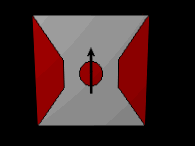
Materials Research Science and Engineering Center: Faculty Publications
Document Type
Article
Date of this Version
6-1-2005
Abstract
Using a first-principles Green's function technique, we study spin-dependent tunneling in two model realizations of (111) fcc Co/Al3/Co tunnel junctions assuming O-terminated crystalline epitaxy in the corundum structure. For the first model, which includes 3 O atoms at the interface, the tunneling current is polarized negatively, just as for the clean Co surface. The second model contains additional oxygen atoms inside large pores at each interface. Located at the three-fold hollow adsorption sites, these O atoms bind very strongly to Co. This bonding creates an interface band in the majority-spin channel which strongly enhances the tunneling current in this channel. As a result, the spin polarization changes sign and becomes positive, similar to that for the oxidized Co surface studied previously. These results show that the common argument of "mostly s-electron tunneling," which is often used to explain the positive spin polarization in Co/Al3 /Co junctions is quantitatively incorrect. In reality, the spin polarization in these junctions is controlled by the interfacial structure and bonding. Moreover, interfacial adsorption of oxygen may be a prerequisite for achieving the positive spin polarization.


Comments
Published in Physical Review B, 71, 224422 (1 June 2005)
Copyright © 2005 The American Physical Society. Used by permission
URL: http://link.aps.org/abstract/PRB/v71/e224422
doi:10.1103/PhysRevB.71.224422